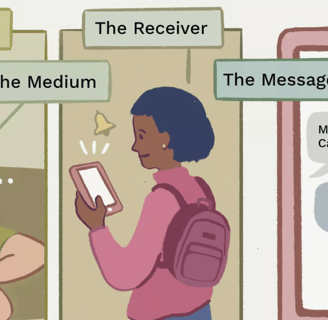Driving Success With The Five Key Components of Communication
Sender, Receiver, Medium, Message, and Feedback
3/26/20242 min read


Communication plays a huge role in marketing strategies and serves as the foundation on which successful campaigns are built. The five key components of communication—sender, receiver, medium, message, and feedback—are not only vital for effective interpersonal communication but are also fundamental when it comes to marketing. Each single component—together and individually—plays a crucial role in conveying brand messages, fostering connections with consumers, and driving business success.
Let’s get into it.
The Sender
The sender represents the entity initiating the communication process. In marketing, this role is typically assumed by the brand or the marketer. The sender is responsible for crafting messages that resonate with the target audience, align with brand objectives, and effectively convey the intended meaning. Understanding the audience demographics, preferences, and behaviors is essential for tailoring messages that capture attention and drive engagement.
The Receiver
The receiver represents the audience or consumers who are the intended recipients of the marketing messages. Understanding the characteristics and needs of the target audience is essential for developing communication strategies that resonate with them. Effective marketing communication involves not only conveying information but also establishing a connection with the audience, evoking emotions, and influencing perceptions to drive desired actions, such as purchasing products or services.
The Medium
This serves as the channel through which messages are transmitted from the sender to the receiver. In today's digital world, marketers have a plethora of mediums at their disposal, including social media, email, websites, mobile apps, traditional advertising channels, and more. Selecting the appropriate medium depends on various factors such as the target audience's preferences, the nature of the message, budget constraints, and the overall marketing objectives. Utilizing multiple mediums in an integrated marketing communications approach can enhance reach and effectiveness by catering to diverse consumer preferences and behaviors.
The Message
The message is the content or information conveyed from the sender to the receiver. In marketing, messages encompass a wide range of elements, including brand storytelling, product features, benefits, promotions, and calls to action. Crafting compelling messages requires a deep understanding of the target audience's needs, desires, and pain points. Marketers must ensure that messages are clear, relevant, and persuasive to capture the audience's attention and motivate them to take the desired action, whether it's making a purchase, signing up for a newsletter, or engaging with the brand on social media.
The Feedback
Lastly, feedback completes the communication loop by providing valuable insights into the effectiveness of the marketing efforts. Feedback can come in various forms, such as customer reviews, surveys, social media comments, sales data, and website analytics. Analyzing feedback allows marketers to evaluate the impact of their messages, identify areas for improvement, and make data-driven decisions to optimize future communication strategies. Additionally, feedback enables brands to engage with their audience, address concerns, and build stronger relationships based on trust and transparency.
In conclusion, the five components of communication—sender, receiver, medium, message, and feedback—are indispensable in the field of marketing. By understanding and leveraging these components effectively, marketers can create compelling campaigns that resonate with their target audience, drive engagement, and ultimately contribute to the success of their brands. Effective communication lies at the heart of building meaningful connections with consumers, and the five components of communication can help establish a competitive edge in today's dynamic marketplace.
